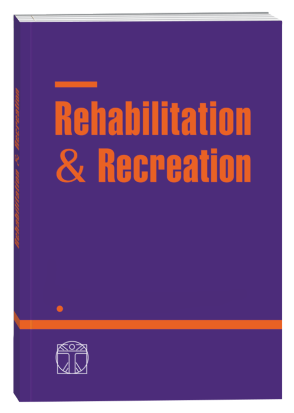СОМАТОМЕТРИЧНІ ПОКАЗНИКИ ДІТЕЙ МОЛОДШОГО ШКІЛЬНОГО ВІКУ, ЯКІ МАЮТЬ СПАСТИЧНУ ФОРМУ ЦЕРЕБРАЛЬНОГО ПАРАЛІЧУ
DOI:
https://doi.org/10.32782/2522-1795.2025.19.1.18Słowa kluczowe:
дитячий церебральний параліч, фізичний розвиток, соматометричні показники, молодший шкільний вік, патологія рухового апарату, фізкультурно-спортивна реабілітаціяAbstrakt
Вступ. Проблема фізкультурно-спортивної реабілітації дітей з інвалідністю нині перебуває в центрі уваги вітчизняної та закордонної науки. Дослідження охоплюють широкий перелік проблем, зумовлених спробами суспільства допомогти дітям-інвалідам. Серед актуальних питань дитячої неврології провідне місце належить проблемі розвитку захворюваності на дитячий церебральний параліч (ДЦП). Мета статті полягає у вивченні соматометричних показників дітей молодшого шкільного віку зі спастичними формами церебрального паралічу. Методи дослідження: теоретичний аналіз і узагальнення літературних джерел, антропометрія, методи математичної статистики. Результати. Вивчення соматометричних показників дітей молодшого шкільного віку зі спастичними формами церебрального паралічу та їх практично здорових однолітків показали, що в дітей зі спастичною диплегією спостерігалися набагато менші довжина тіла (на 1,4 сантиметра) і маса тіла (на 1,3 кілограма) порівняно із практично здоровими дітьми, що свідчить про значний вплив цієї форми церебрального паралічу на фізичний розвиток. Водночас окружність грудної клітки в них залишалася подібною до показників практично здорових дітей, без статистично значущих відмінностей. У дітей зі спастичним геміпарезом відмінності в довжині тіла, масі тіла й окружності грудної клітки із практично здоровими дітьми не були статистично значущими, тобто спастичний геміпарез меншою мірою порушує показники фізичного розвитку, що робить їх більш наближеними до вікових норм. Додатковим підтвердженням цього висновку є виявлений факт, що їхня маса тіла була значно більшою, ніж у дітей зі спастичною диплегією. Висновки. Діти зі спастичною диплегією мають значно нижчі показники довжини та маси тіла, що пов’язано з більш вираженими порушеннями рухової функції та впливом церебрального паралічу на метаболічні процеси. Натомість діти зі спастичним геміпарезом демонструють кращі показники фізичного розвитку, наближені до показників практично здорових дітей. Окружність грудної клітки в усіх групах залишається стабільною, що може бути маркером анатомічної клітини й однієї незалежності цього параметра від рухових пошкоджень.
Bibliografia
1. Кашуба В., Чухловина В. Технологія корекції рухових порушень у дітей молодшого шкільного віку зі спастичними формами церебрального паралічу. Спортивний вісник Придніпров’я. 2017. № 2. С. 177–82.
2. Кашуба В., Чухловіна В. Сучасні погляди на корекцію рухових порушень у дітей молодшого шкільного віку зі спастичними формами церебрального паралічу. Вісник Прикарпатського університету. Серія «Фізична культура». 2017. № № 25–26. С. 160–68.
3. Холодов С. Сучасні тренди у практиці фізкультурно-спортивної реабілітації дітей із церебральним паралічем. Фізична культура, спорт та здоров’я нації. 2022. № 13 (32). С. 336–45. DOI: 10.31652/2071-5285-2022-13(32)-336-345.
4. Холодов С., Гребеніна А. Біомеханіка постави дітей із церебральним паралічем: сучасний стан проблеми. Rehabilitation & recreation.2023. № 14. С. 242–251. https://doi.org/10.32782/2522-1795.2023.14.29.
5. Araújo L.A., Silva L.R. Anthropometric assessment of patients with cerebral palsy: which curves are more appropriate? Jornal de Pediatria. 2013. № 89 (3). С. 307–314. https://doi.org/10.1016/j.jped.2012.11.008.
6. Bell K.L. et al. Use of segmental lengths for the assessment of growth in children with cerebral palsy. Handbook of anthropometry. New York, 2012. P. 1279–1297. https://doi.org/10.1007/978-1-4419-1788-1_78.
7. Kashuba V., Bukhovets B. The indicators of physical development of children with Cerebral Palsy as the basis of differential approach to implementation of the physical rehabilitation program of using Bobath-therapy method. Journal of Education, Health and Sport. 2017. № 7 (3). P. 835–849.
8. Kholodov S., Kashuba V., Khmelnitska I., Grygus I., Asauliuk I., Krupenya S. Model biomechanical characteristics of child’s walking during primary school age. Journal of Physical Education and Sport. 2021. Vol. 21. Suppl. issue 5. P. 2857 – 2863. DOI: 10.7752/jpes.2021.s5380.
9. Kholodov S., Savlyuk O., Hrebenina A., Yarmolinsky L., Kolos M. Methodology of “artificial control environment” in the process of physical exercise for children with disabilities: theoretical justification and practical application. Physical rehabilitation and recreational health technologies. 2024. Vol. 9. № 5. Р. 370–384. https://doi.org/10.15391/prrht.2024-9(5).
10. Lamounier J.A. et al. Stature estimate of children with cerebral palsy through segmental measures: a systematic review. Revista paulista de pediatria. 2020. Vol. 38. https://doi.org/10.1590/1984-0462/2020/38/2018185.
11. Lee S.Y., Chung C.Y. et al. Annual changes in radiographic indices of the spine in cerebral palsy patients. Eur Spine J. 2016. № 25. P. 679–686. DOI: 10.1007/s00586-014-3746-4.
12. Porter D., Michael S. et al. Patterns of postural deformity in non-ambulant people with cerebral palsy: what is the relationship between the direction of scoliosis, direction of pelvic obliquity, direction of windswept hip deformity and side of hip dislocation? Clin Rehabil. 2007. № 21. P. 1087–1096.
Pobrania
Opublikowane
Jak cytować
Numer
Dział
Licencja

Utwór dostępny jest na licencji Creative Commons Uznanie autorstwa – Użycie niekomercyjne – Bez utworów zależnych 4.0 Międzynarodowe.





